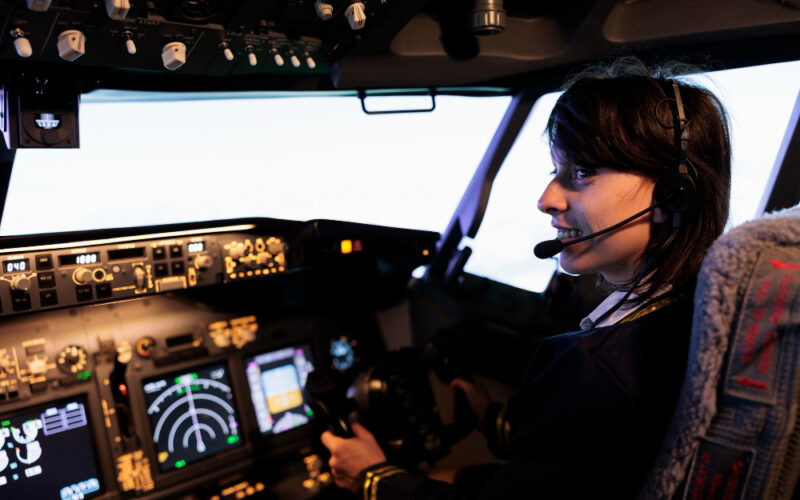Many people have a dream of flying. Unfortunately, not all people can do it. Also, people who need to be trained for piloting need a lot of experience flying in various scenarios and be ready for every type of abnormal procedure. However, flying and training with real planes needs fuel, instructors, and a runway, which is time-limited, requires a huge amount of money, and can be hard and dangerous. This is why the thing called a “flight simulator” was invented (Royal Air Force Museum, 2020).
A flight simulator is a training system that can simulate any kind of weather, place, or situation on the ground. The flight simulator helps trainers train in many different conditions without taking on big risks or danger. It also gives some indirect experience without subjecting those who want to try to fly to real-life flying situations. Some simulators have simple instruments and monitors, and some high-end simulators have mockup cockpits, six DOF (degrees of freedom) actuators, and other effects that give a realistic feeling to the users (Wikipedia contributors, 2023).
However, flight simulators in the past were very different from those nowadays. One of the earliest flight simulators was made by Edwin Link in 1927 in New York, and it was called Link Trainer. The Link Trainer has the nickname “Blue Box” because it literally looks like and is made out of a wooden box. This simulator worked with no electricity. It was operated by an engine-powered air pump below the simulator. It didn’t have a display to show the terrain, which meant the pilot in that simulator had to fly the simulator almost totally blind and fly by its own feelings and compass. It may seem that it is not useful. However, it was very effective for training. Since it had no visual sight, it helped trainers get used to IFR (instrument reference flight). More than 500,000 pilots were trained with the Link Trainer during World War II (Milton J. Rubenstein Museum of Science and Technology, 2023).
Now, the flight simulator has become a computer-based simulation. The computer-based simulator made the simulation as realistic as possible by using a high-quality physics engine that can calculate aerodynamics on planes like drag, lift, and engine thrust. Moreover, the difference in flow of air, moisture, and air density by terrain and weather is calculated and affects the plane in the simulator. These simulators are used for a lot of purposes, like pilot training, job experiments for kids, and designing new aircraft or cockpits (Hayward and Singh, 2022).
In addition, the flight simulator helps in aviation accident investigations. For example, while investigating US Airways Flight 1549, which is called Miracle on the Hudson, it helped the pilot prove the human factor by testing the same flight in the simulation on other pilots in almost the same situation as possible with a 35-second delay for replicating the human factor. The run failed to land on any airport, which means the landing on the Hudson River was the best decision (NTSB, 2009).
Being in charge of an aircraft of any size can be nerve-racking, especially for beginners. People frequently make more mistakes when they are stressed or nervous. Students can practice and refine their skills in a safe and controlled setting since flight simulators simulate various flight circumstances. Students are relaxed and can focus more on their training because they know they are on the ground. They will also be less concerned about making mistakes and will be able to devote more time to learning from them. Using flight simulators to train pilots is an efficient method. They supplement real-life flying events while removing the actual dangers. Pilots can use this useful training tool to practice flight skills and instrument controls in a safe and controlled environment.
Students can execute maneuvers and standard protocol quietly in a flight simulator, increasing their chances of learning and growing more confident in their abilities.
Reference
Hayward, J. and Singh, S. (2022). What Is A Level D Simulator? [online] Simple Flying. Available at: https://simpleflying.com/level-d-simulator/ [Accessed 6 May 2023].
Milton J. Rubenstein Museum of Science & Technology. (2023). Link Flight Trainer. [online] Available at: https://www.most.org/explore/link-flight-trainer/ [Accessed 6 May 2023].
NTSB (2009). National Transportation Safety Board. [online] Available at: https://www.ntsb.gov/investigations/AccidentReports/Reports/AAR1003.pdf [Accessed 6 May 2023].
Royal Air Force Museum (2020). Flight Simulation and Synthetic Trainers | Historical Periods | Taking flight | Exhibitions & Displays | Research. [online] RAF Museum. Available at: https://www.rafmuseum.org.uk/research/online-exhibitions/taking-flight/historical-periods/flight-simulation-and-synthetic-trainers/ [Accessed 6 May 2023].
